Sarah Monette's Blog, page 23
March 2, 2014
Katherine Addison
So my publicist at Tor asked if she could get a headshot of Katherine Addison for dissemination to Tor.com and C2E2 and the like, and I thought, What the hell. If I'm going to do it, I might as well go all out.
So this is baseline me, as you should imagine me behind pretty much anything I post:

And this is Katherine Addison, who turns out to be a steampunk kind of lady:
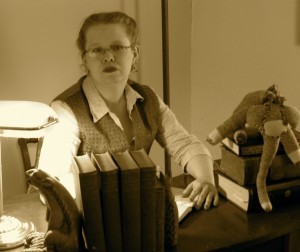
She takes good headshots, too:


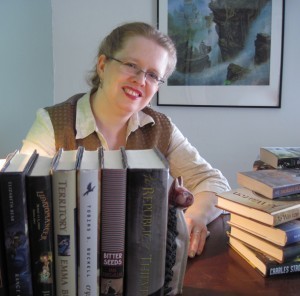
So this is baseline me, as you should imagine me behind pretty much anything I post:

And this is Katherine Addison, who turns out to be a steampunk kind of lady:

She takes good headshots, too:



Published on March 02, 2014 12:49
February 27, 2014
UBC: Collins, Merritt, O'Brien
Collins, Paul. The Murder of the Century: The Gilded Age Crime That Scandalized a City & Sparked The Tabloid Wars. New York: Crown Publishers, 2011.
Merritt, Greg. Room 1219: The Life of Fatty Arbuckle, the Mysterious Death of Virginia Rappe, and the Scandal that Changed Hollywood. Chicago: A Cappella-Chicago Review Press, 2013.
O'Brien, Geoffrey. The Fall of the House of Walworth: A Tale of Madness and Murder in Gilded Age America. New York: St. Martin's Griffin, 2010.
These three books are about cause célèbre murders, each about twenty years apart: 1873, 1897, 1921. And one of the interesting things about them is that, of the three, the only one anyone now has even heard of is the one that wasn't a murder at all: the death of Virginia Rappe--and most of what we vaguely "know" about her death is wrong. About the other two, the murder of Mansfield Tracy Walworth by his son Frank and the murder of William Guldensuppe by Augusta Nack and Martin Thorn, I feel fairly safe in saying that, unless you've read O'Brien or Collins, you've never heard a thing. And yet these were HOWLED about by the newspapers in 1873 and 1897 and both have a certain amount of historical importance, the Walworth murder for being the first second-degree murder trial in New York, the Guldensuppe murder for the comet-like rise of the repellent William Randolph Hearst and his Journal. So one of the things I learned from all three books is how quickly a cause célèbre evaporates from human memory.
All three of these books are excellent, although each is very different from the other two. The O'Brien is intensely Gothic Victorian, as are the lives of its subjects. (I was half persuaded, all the way through, that I was being gaslighted and The Fall of the House of Walworth was actually a novel. But the central person of the book, Ellen Hardin Walworth, was one of the founders of the DAR, so if it's a scam, the Daughters of the American Revolution are in on it.) It is in some ways the most frustrating of the three, not because of anything O'Brien is doing wrong, but because, first of all, the people are frustrating for their failures and their blindnesses (as real people are wont to be), especially Ellen Hardin Walworth herself, who, for all the time she spent in introspection, never seems to have seen herself clearly at all. (Mansfield is not frustrating. Mansfield is HORRIFYING, and I admit I ended up reading those parts of the book in breathless curiosity about what awful thing Mansfield would do next.)
The other reason for frustration is that the central ACT of the book, the murder of Mansfield Walworth, remains inaccessible. It is not a mystery--there was never any doubt, first to last, that Frank Walworth murdered his father--but it simply cannot be seen. One of the other things these three books have shown me with bitter clarity is that murder trials are not about finding the truth. They are about the competition of narratives, and both prosecution and defense will shape their narrative to defeat the competition, not to try to reveal the truth about anything. And all we know about the murder of Mansfield Walworth comes from Frank's trial. Was it premeditated, as the prosecution argued? Was Frank epileptic, as the defense argued, and ought he to be found therefore not guilty by reason of insanity? (Victorian doctors considered epilepsy a form of insanity.) The evidence is both scant and contradictory, and we are left simply not knowing. O'Brien is far more a biographer than a criminologist; he doesn't assess the evidence for or against, makes no effort at a meta-narrative. I find that frustrating, but I also recognize that that's because I come to these things as a mystery reader first and a historian (insofar as I can make any claim to that title) second. His failure to do what I want is not a flaw. And what he is doing, he does brilliantly.
Collins, on the other hand, is writing for mystery readers as well as for historians, and his book does explicitly what I often wish true crime books would do. He follows the course of the discovery of Guldensuppe's dismembered body, the course of the investigation, the trial, the execution of Martin Thorn and what can be determined about the later life of Augusta Nack, and then he steps back and points out that the evidence tells a story that never came out in the trial, because, after Nack turned state's evidence, she and Thorn were both committed to insisting on the complete innocence of themselves and the complete guilt of the other party. Nack's narrative won, and the truth--that the wounds on Guldensuppe's body indicate that Nack and Thorn must have been working together--was at that point simply not important enough to anyone to be bothered with.
(Apparently, I am an idealist. It offends me that there is no space in our legal system for anyone to say, "Both prosecution and defense are bypassing the truth.")
Collins' book is the most straightforward of the three, the most clearly a "true crime" book. He tells a complicated story consisely and elegantly and has done all kinds of research. But the book does not have either the baroque form-mirroring-content style of O'Brien's or the argumentative thesis of Merritt's.
Merritt's book is a biography of Roscoe Arbuckle (he put up with the nickname "Fatty" for his career, but no one who knew him called him that), and of Virginia Rappe (pronounced "rappay"), insofar as Merritt was able to unearth information about her; it is also, therefore, an excellent book about silent movies and the beginnings of Hollywood. But mostly it is the terrible story of the point where Arbuckle and Rappe's lives intersected and the consequences thereof. Merritt is passionately interested in finding the truth, about Rappe as much about Arbuckle, and dispelling the myths: he raped her with a bottle; she "had it coming" because she was a slut. I don't entirely know if I agree with his conclusions, but I appreciate the care with which he lays out the shreds and shards of evidence we have around the missing central act of what happened in Room 1219.
The terrible thing about Roscoe Arbuckle is that he is a sort of Schrodinger's cat of justice. If he did attempt to rape Virginia Rappe and thus caused her death, he got away with it. Tried three times and acquitted of manslaughter. But if he didn't attempt to rape her, if her death was truly the ghastly accident Merritt thinks it was, then his fate, the destruction of his career, was unjustifiably cruel. In neither case can one feel that justice was served.
Merritt, Greg. Room 1219: The Life of Fatty Arbuckle, the Mysterious Death of Virginia Rappe, and the Scandal that Changed Hollywood. Chicago: A Cappella-Chicago Review Press, 2013.
O'Brien, Geoffrey. The Fall of the House of Walworth: A Tale of Madness and Murder in Gilded Age America. New York: St. Martin's Griffin, 2010.
These three books are about cause célèbre murders, each about twenty years apart: 1873, 1897, 1921. And one of the interesting things about them is that, of the three, the only one anyone now has even heard of is the one that wasn't a murder at all: the death of Virginia Rappe--and most of what we vaguely "know" about her death is wrong. About the other two, the murder of Mansfield Tracy Walworth by his son Frank and the murder of William Guldensuppe by Augusta Nack and Martin Thorn, I feel fairly safe in saying that, unless you've read O'Brien or Collins, you've never heard a thing. And yet these were HOWLED about by the newspapers in 1873 and 1897 and both have a certain amount of historical importance, the Walworth murder for being the first second-degree murder trial in New York, the Guldensuppe murder for the comet-like rise of the repellent William Randolph Hearst and his Journal. So one of the things I learned from all three books is how quickly a cause célèbre evaporates from human memory.
All three of these books are excellent, although each is very different from the other two. The O'Brien is intensely Gothic Victorian, as are the lives of its subjects. (I was half persuaded, all the way through, that I was being gaslighted and The Fall of the House of Walworth was actually a novel. But the central person of the book, Ellen Hardin Walworth, was one of the founders of the DAR, so if it's a scam, the Daughters of the American Revolution are in on it.) It is in some ways the most frustrating of the three, not because of anything O'Brien is doing wrong, but because, first of all, the people are frustrating for their failures and their blindnesses (as real people are wont to be), especially Ellen Hardin Walworth herself, who, for all the time she spent in introspection, never seems to have seen herself clearly at all. (Mansfield is not frustrating. Mansfield is HORRIFYING, and I admit I ended up reading those parts of the book in breathless curiosity about what awful thing Mansfield would do next.)
The other reason for frustration is that the central ACT of the book, the murder of Mansfield Walworth, remains inaccessible. It is not a mystery--there was never any doubt, first to last, that Frank Walworth murdered his father--but it simply cannot be seen. One of the other things these three books have shown me with bitter clarity is that murder trials are not about finding the truth. They are about the competition of narratives, and both prosecution and defense will shape their narrative to defeat the competition, not to try to reveal the truth about anything. And all we know about the murder of Mansfield Walworth comes from Frank's trial. Was it premeditated, as the prosecution argued? Was Frank epileptic, as the defense argued, and ought he to be found therefore not guilty by reason of insanity? (Victorian doctors considered epilepsy a form of insanity.) The evidence is both scant and contradictory, and we are left simply not knowing. O'Brien is far more a biographer than a criminologist; he doesn't assess the evidence for or against, makes no effort at a meta-narrative. I find that frustrating, but I also recognize that that's because I come to these things as a mystery reader first and a historian (insofar as I can make any claim to that title) second. His failure to do what I want is not a flaw. And what he is doing, he does brilliantly.
Collins, on the other hand, is writing for mystery readers as well as for historians, and his book does explicitly what I often wish true crime books would do. He follows the course of the discovery of Guldensuppe's dismembered body, the course of the investigation, the trial, the execution of Martin Thorn and what can be determined about the later life of Augusta Nack, and then he steps back and points out that the evidence tells a story that never came out in the trial, because, after Nack turned state's evidence, she and Thorn were both committed to insisting on the complete innocence of themselves and the complete guilt of the other party. Nack's narrative won, and the truth--that the wounds on Guldensuppe's body indicate that Nack and Thorn must have been working together--was at that point simply not important enough to anyone to be bothered with.
(Apparently, I am an idealist. It offends me that there is no space in our legal system for anyone to say, "Both prosecution and defense are bypassing the truth.")
Collins' book is the most straightforward of the three, the most clearly a "true crime" book. He tells a complicated story consisely and elegantly and has done all kinds of research. But the book does not have either the baroque form-mirroring-content style of O'Brien's or the argumentative thesis of Merritt's.
Merritt's book is a biography of Roscoe Arbuckle (he put up with the nickname "Fatty" for his career, but no one who knew him called him that), and of Virginia Rappe (pronounced "rappay"), insofar as Merritt was able to unearth information about her; it is also, therefore, an excellent book about silent movies and the beginnings of Hollywood. But mostly it is the terrible story of the point where Arbuckle and Rappe's lives intersected and the consequences thereof. Merritt is passionately interested in finding the truth, about Rappe as much about Arbuckle, and dispelling the myths: he raped her with a bottle; she "had it coming" because she was a slut. I don't entirely know if I agree with his conclusions, but I appreciate the care with which he lays out the shreds and shards of evidence we have around the missing central act of what happened in Room 1219.
The terrible thing about Roscoe Arbuckle is that he is a sort of Schrodinger's cat of justice. If he did attempt to rape Virginia Rappe and thus caused her death, he got away with it. Tried three times and acquitted of manslaughter. But if he didn't attempt to rape her, if her death was truly the ghastly accident Merritt thinks it was, then his fate, the destruction of his career, was unjustifiably cruel. In neither case can one feel that justice was served.
Published on February 27, 2014 13:07
February 26, 2014
The Hounds of Winter
More Mirkwood by Tiffany this morning, a little more traditional but still eerily lovely:


And this is the fang a Hound of Winter left in the apple tree whilst prowling around our house:



And this is the fang a Hound of Winter left in the apple tree whilst prowling around our house:

Published on February 26, 2014 11:01
February 25, 2014
In memoriam: Harold Ramis
Harold Ramis died yesterday.
Egon Spengler lives on, because cinematographic technology preserves him forever (or at least for a good while longer), and thank goodness for that.
But I am still just . . . I am a little bit heartbroken.
Egon Spengler lives on, because cinematographic technology preserves him forever (or at least for a good while longer), and thank goodness for that.
But I am still just . . . I am a little bit heartbroken.
Published on February 25, 2014 12:01
February 23, 2014
Translation asymmetry and a way to fight it
Ben Rosenbaum has a great idea about redressing the imbalance between the translation of Anglophone authors into other languages and the tranlsation of non-Anglophone authors into English. (Hint: the imbalance is enormous.) Aliette de Bodard and Alex Shvartsman are on board. Which puts the languages available at: German, Spanish, French, Russian, Hebrew, and Vietnamese (with varying degrees of fluency on the part of the volunteer translators).
I would love to be able to add my name to the list, but the languages I am best at are dead. (Also, even if anyone wanted to trust my very rusty French, I honestly don't have the time/energy to commit to it. I was a Classics major in college; I know just how demanding a job translation is, and I know I can't do it right now.) But I want to do what I can, which is to boost the signal and encourage other authors to join in.
Seriously. This is a GREAT idea.
I would love to be able to add my name to the list, but the languages I am best at are dead. (Also, even if anyone wanted to trust my very rusty French, I honestly don't have the time/energy to commit to it. I was a Classics major in college; I know just how demanding a job translation is, and I know I can't do it right now.) But I want to do what I can, which is to boost the signal and encourage other authors to join in.
Seriously. This is a GREAT idea.
Published on February 23, 2014 08:41
REMINDER: Con or Bust
The Con or Bust auction ends at 5 p.m. Eastern Standard Time today.
This is me encouraging you, if you were thinking about bidding on something, to do so!
(Please forgive any infelicities. I have a migraine.)
This is me encouraging you, if you were thinking about bidding on something, to do so!
(Please forgive any infelicities. I have a migraine.)
Published on February 23, 2014 07:37
February 22, 2014
UBC: Halttunen
Halttunen, Karen. Murder Most Foul: The Killer and the American Gothic Imagination. Cambridge, MA: Harvard University Press, 1998.
My initial reservations about this book have been vindicated. Halttunen is an unnuanced reader, with the difficulty common to both historians and literary critics of confusing fiction and nonfiction primary sources. (The fact that some of Halttunen's primary sources are heavily-fictionalized accounts of nominally nonfictional events merely underlines in red the need for a nuanced and careful discussion of the nature of fiction here.) She persists throughout in praising the Puritan view of murderers as a compassionate one, as opposed to the Gothic view that alienated them from "normal" human beings. (And she missed a great opportunity to use Kristeva's idea of abjection.) Now, I'm not arguing that the Gothic/Enlightenment formulation of human nature didn't alienate murderers and other criminals from the rest of humanity or that it is not a formulation that desperately needs to be deconstructed, questioned, and debunked. But I still feel that there's something fundamentally flawed about her argument:
I don't think that what she's describing is empathy, and I don't think that the simplistic unquestioning view of human nature as fallen, sinful, and inherently evil is better than the struggle over the past two centuries to question that doctrine, even though she points out, as if it somehow invalidated the process of asking, that we don't have answers to the questions of how and why people commit evil. (She seems to feel that the failure to find satisfactory answers is what feeds our insatiable hunger for true crime. Presumably also for mystery fiction? Since she doesn't distinguish clearly between fiction and nonfiction, I suppose it must be.) Her epilogue, in which she discusses Dead Man Walking and Seven, praises Morgan Freeman's character in the latter and Sister Prejean in the former, aligning both explicitly with the Puritan execution sermons, because "they will not label murderers as moral aberrations, subhuman monsters. They murderer, they agree, is not the devil; he's just a man, subject to sin as they themselves are subject to sin. . . . Significantly, neither Detective Somerset nor Sister Prejean is particularly engaged with the challenge of satisfactorily explaining human evil. It is enough simply to acknowledge its universality" (250). This book suggests that a liberal, secular worldview is a bad thing to have, and I don't agree with that at all
(Also, she's still wrong about the origins of horror as a genre.)
Halttunen also has the slumming problem; she spends the whole book holding her subject matter at arm's length (and she would much rather discuss theories about murderers and victims and narratives than the narratives themselves). Now, I will be the first to admit that true crime, as a genre, is morally and ethically problematic, but I don't agree with Halttunen that that means we get to congratulate ourselves on being above all that . . . as we read a book about true crime. I think that any book about true crime (which is what her book is about) needs to grapple with the fact that human beings do read about murder, and needs to work out a theory of why that can provide something more like an answer than Sam the Eagle's "You are all weirdos."
My initial reservations about this book have been vindicated. Halttunen is an unnuanced reader, with the difficulty common to both historians and literary critics of confusing fiction and nonfiction primary sources. (The fact that some of Halttunen's primary sources are heavily-fictionalized accounts of nominally nonfictional events merely underlines in red the need for a nuanced and careful discussion of the nature of fiction here.) She persists throughout in praising the Puritan view of murderers as a compassionate one, as opposed to the Gothic view that alienated them from "normal" human beings. (And she missed a great opportunity to use Kristeva's idea of abjection.) Now, I'm not arguing that the Gothic/Enlightenment formulation of human nature didn't alienate murderers and other criminals from the rest of humanity or that it is not a formulation that desperately needs to be deconstructed, questioned, and debunked. But I still feel that there's something fundamentally flawed about her argument:
To be sure, defense attorneys routinely appealed to jurors' compassion for their mentally afflicted defendants: Daniel Corey, argued his attorney, "is much more entitled to compassion and protection, than to severity." But such compassion was dramatically different from the early American sympathy invoked for the "Poor Man" Jeremiah Meacham. Whereas the compassion for Meacham was grounded in empathy, a genuine identification of all people with the universal fallen state they shared with the condemned criminal, the compassion invoked for the nineteenth-century mad person was grafted onto radical difference.
(236)
I don't think that what she's describing is empathy, and I don't think that the simplistic unquestioning view of human nature as fallen, sinful, and inherently evil is better than the struggle over the past two centuries to question that doctrine, even though she points out, as if it somehow invalidated the process of asking, that we don't have answers to the questions of how and why people commit evil. (She seems to feel that the failure to find satisfactory answers is what feeds our insatiable hunger for true crime. Presumably also for mystery fiction? Since she doesn't distinguish clearly between fiction and nonfiction, I suppose it must be.) Her epilogue, in which she discusses Dead Man Walking and Seven, praises Morgan Freeman's character in the latter and Sister Prejean in the former, aligning both explicitly with the Puritan execution sermons, because "they will not label murderers as moral aberrations, subhuman monsters. They murderer, they agree, is not the devil; he's just a man, subject to sin as they themselves are subject to sin. . . . Significantly, neither Detective Somerset nor Sister Prejean is particularly engaged with the challenge of satisfactorily explaining human evil. It is enough simply to acknowledge its universality" (250). This book suggests that a liberal, secular worldview is a bad thing to have, and I don't agree with that at all
(Also, she's still wrong about the origins of horror as a genre.)
Halttunen also has the slumming problem; she spends the whole book holding her subject matter at arm's length (and she would much rather discuss theories about murderers and victims and narratives than the narratives themselves). Now, I will be the first to admit that true crime, as a genre, is morally and ethically problematic, but I don't agree with Halttunen that that means we get to congratulate ourselves on being above all that . . . as we read a book about true crime. I think that any book about true crime (which is what her book is about) needs to grapple with the fact that human beings do read about murder, and needs to work out a theory of why that can provide something more like an answer than Sam the Eagle's "You are all weirdos."
Published on February 22, 2014 18:39
February 21, 2014
I number things. It lets me pretend that order can triumph over chaos.
1. Yesterday I posed with a giant inflatable colon to promote colorectal cancer awareness. Most surreal Thursday morning ever.
Yes, a colonoscopy is not the most fun you will ever have, but speaking as a friend of the awesome Jay Lake and as someone who has had a polyp removed from her colon and will be going back for another screening in a couple years, colon cancer needs to be beaten to death with a stick.
2. Liz Bourke has reviewed The Goblin Emperor for Tor.com. As an author, positive reviews are great, but what you really want are good reviews, reviews that understand the book you tried to write and convey it well. This is that kind of review.
3. I am currently undergoing all kinds of adjustments to my . . . I don't even know what to call it. The victory conditions for sleep? They're shipping me a different mask to try with the little Cthulhu machine. It will still look like a disastrous attempt at an elephant costume, but hopefully it will (a) be more comfortable and (b) seal to my face better. Yes, I have seen Aliens. Please don't remind me.
But ALSO, my sleep doctor and I are trying to rejigger my RLS medications, because I'd gotten to the point where it was requiring way too much narcotics to club the damn thing into unconsciousness. The new medication is definitely working, so that's a plus, and I am re-weaning myself off the narcotics. Yes, there has been just a tiny bit of withdrawal. I haven't gone off them entirely yet, but I am working on it because I hate the damn drugs. I am hoping that when I can finally stop taking them, I will be less tired and also that my creativity will come back again.
It did come back in December and January before drying up again in February, and the creepy thing is that I can actually articulate the difference. When everything is working correctly (i.e., what I thought of as "normal" until the clusterfuck began in 2010), there are words in my head. Well, there are always words in my head. I am like Hector Puncheon, who "usually thought articulately, and often, indeed, conversed quite sensibly aloud with his own soul." So maybe it's more accurate to say that the staus quo ante, to which I desire ardently to return, is that there are stories forming, word by word. Because there are words, separate from my internal narration/dialogue. They form themselves into sentences, and the sentences form narratives. When it was working right, I would frequently "get" sentences from Booth out of nowhere.
Now, I can force prose. There are always days when you have to. But it's not the same, at least from my side of the proscenium, and I really didn't realize what I'd lost until I had it back. I didn't realize that there was a wellspring, that I wasn't imagining that writing used to involve joy instead of just grim desperation.
I had it back, and then the RLS went bad, and it was gone again. I knew that bad RLS nights correlated with low or nonexistent creativity, and now I know what it's attacking. I know that there's a thing that should be there that isn't. And I can only hope that it can grow back. Again.
Yes, a colonoscopy is not the most fun you will ever have, but speaking as a friend of the awesome Jay Lake and as someone who has had a polyp removed from her colon and will be going back for another screening in a couple years, colon cancer needs to be beaten to death with a stick.
2. Liz Bourke has reviewed The Goblin Emperor for Tor.com. As an author, positive reviews are great, but what you really want are good reviews, reviews that understand the book you tried to write and convey it well. This is that kind of review.
3. I am currently undergoing all kinds of adjustments to my . . . I don't even know what to call it. The victory conditions for sleep? They're shipping me a different mask to try with the little Cthulhu machine. It will still look like a disastrous attempt at an elephant costume, but hopefully it will (a) be more comfortable and (b) seal to my face better. Yes, I have seen Aliens. Please don't remind me.
But ALSO, my sleep doctor and I are trying to rejigger my RLS medications, because I'd gotten to the point where it was requiring way too much narcotics to club the damn thing into unconsciousness. The new medication is definitely working, so that's a plus, and I am re-weaning myself off the narcotics. Yes, there has been just a tiny bit of withdrawal. I haven't gone off them entirely yet, but I am working on it because I hate the damn drugs. I am hoping that when I can finally stop taking them, I will be less tired and also that my creativity will come back again.
It did come back in December and January before drying up again in February, and the creepy thing is that I can actually articulate the difference. When everything is working correctly (i.e., what I thought of as "normal" until the clusterfuck began in 2010), there are words in my head. Well, there are always words in my head. I am like Hector Puncheon, who "usually thought articulately, and often, indeed, conversed quite sensibly aloud with his own soul." So maybe it's more accurate to say that the staus quo ante, to which I desire ardently to return, is that there are stories forming, word by word. Because there are words, separate from my internal narration/dialogue. They form themselves into sentences, and the sentences form narratives. When it was working right, I would frequently "get" sentences from Booth out of nowhere.
Now, I can force prose. There are always days when you have to. But it's not the same, at least from my side of the proscenium, and I really didn't realize what I'd lost until I had it back. I didn't realize that there was a wellspring, that I wasn't imagining that writing used to involve joy instead of just grim desperation.
I had it back, and then the RLS went bad, and it was gone again. I knew that bad RLS nights correlated with low or nonexistent creativity, and now I know what it's attacking. I know that there's a thing that should be there that isn't. And I can only hope that it can grow back. Again.
Published on February 21, 2014 11:43
February 18, 2014
Join John and Mary's Insect Army! and other better uses of your time
So there has recently been some (more) ugliness in the online science fiction community with some (more) spouting of bigoted claptrap. I don't particularly want either to link to it or to talk about it, but I do want to link to three responses:
N. K. Jemisin's explanation of the misappropration of the First Amendment in the Truesdale petition
John Scalzi's exhortation to Join the Insect Army!
Juliet E. McKenna on Why the SFWA Shoutback Matters
Ms. McKenna's post includes some comments on the invisibility of female writers of epic fantasy (which comments I can testify to the truthfulness of from personal experience), and in fist-shaking defiance of that invisibility I shall tell you that matociquala
's
The Steles of the Sky
got a starred review from
Kirkus Reviews
: "Considering the trilogy as a whole, the overused term masterpiece justifiably applies."
matociquala
's
The Steles of the Sky
got a starred review from
Kirkus Reviews
: "Considering the trilogy as a whole, the overused term masterpiece justifiably applies."
And since Mary Robinette Kowal was the person with the bullseye painted on her in this go-round, I also wish to commend her to you as a writer, a puppeteer, a fearless (former) SFWA officer, and an excellent human being.
Also, this seems like a good moment to remind you that the Con or Bust auction is still ongoing (through February 23), and the plethora of awesome items is downright bedazzling. Should you be interested in my particular items, he bidding for Unnatural Creatures stands at $80 and the bidding for The Goblin Emperor stands at $200.
N. K. Jemisin's explanation of the misappropration of the First Amendment in the Truesdale petition
John Scalzi's exhortation to Join the Insect Army!
Juliet E. McKenna on Why the SFWA Shoutback Matters
Ms. McKenna's post includes some comments on the invisibility of female writers of epic fantasy (which comments I can testify to the truthfulness of from personal experience), and in fist-shaking defiance of that invisibility I shall tell you that
 matociquala
's
The Steles of the Sky
got a starred review from
Kirkus Reviews
: "Considering the trilogy as a whole, the overused term masterpiece justifiably applies."
matociquala
's
The Steles of the Sky
got a starred review from
Kirkus Reviews
: "Considering the trilogy as a whole, the overused term masterpiece justifiably applies."And since Mary Robinette Kowal was the person with the bullseye painted on her in this go-round, I also wish to commend her to you as a writer, a puppeteer, a fearless (former) SFWA officer, and an excellent human being.
Also, this seems like a good moment to remind you that the Con or Bust auction is still ongoing (through February 23), and the plethora of awesome items is downright bedazzling. Should you be interested in my particular items, he bidding for Unnatural Creatures stands at $80 and the bidding for The Goblin Emperor stands at $200.
Published on February 18, 2014 11:28
February 17, 2014
Starred review! Dust jacket! Also kitty!
ETA: Kirkus gives The Goblin Emperor a starred review. Please add exclamation points to taste.
My splendid editor, casacorona
, has an equally splendid assistant, who today sent me the dust jacket for The Goblin Emperor.
casacorona
, has an equally splendid assistant, who today sent me the dust jacket for The Goblin Emperor.
Fig. 1: My lovely assistant Catzilla* will show it to you:

Fig. 2: What do you mean, that isn't what you wanted?
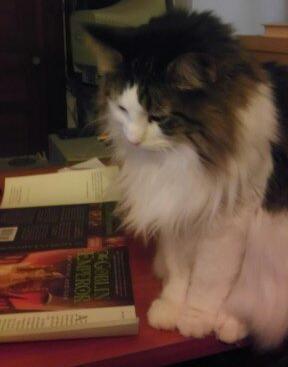
Fig. 3: For somebody we only keep around for your thumbs, you're AWFULLY picky.
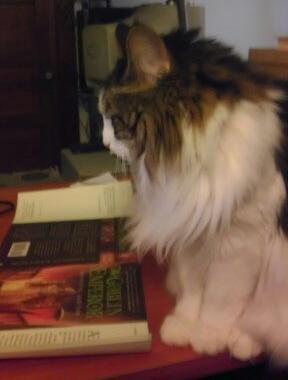
Fig. 4: Is THIS better?
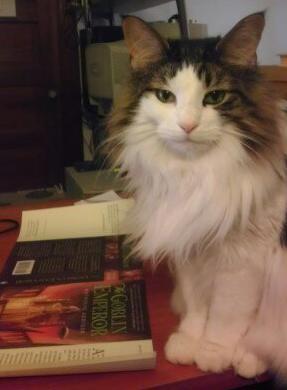
Perfect, Catzilla. Thank you.
---
*No, Catzilla isn't his real name. It's his internet handle.
My splendid editor,
 casacorona
, has an equally splendid assistant, who today sent me the dust jacket for The Goblin Emperor.
casacorona
, has an equally splendid assistant, who today sent me the dust jacket for The Goblin Emperor.Fig. 1: My lovely assistant Catzilla* will show it to you:

Fig. 2: What do you mean, that isn't what you wanted?

Fig. 3: For somebody we only keep around for your thumbs, you're AWFULLY picky.

Fig. 4: Is THIS better?

Perfect, Catzilla. Thank you.
---
*No, Catzilla isn't his real name. It's his internet handle.
Published on February 17, 2014 11:07



